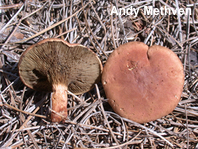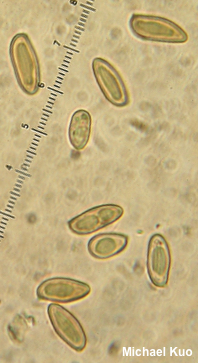| Major Groups > Gilled Mushrooms > Phylloporus & Phylloporopsis > Phylloporopsis boletinoides |

|
Phylloporopsis boletinoides [ Basidiomycota > Boletales > Boletaceae > Phylloporopsis . . . ] by Michael Kuo, 21 October 2025 Among the gilled boletes, Phylloporopsis boletinoides is a southeastern species, recognized by its association with hard pines (those with needles in bundles of 2 or 3), its dull yellowish gills (they're never bright yellow) that become yellowish brown with age, and the pink to purple ammonia reaction of the fresh cap surface. Additionally, the gills are often irregular and nearly poroid, especially near the stem. Phylloporopsis boletinoides was originally described as a species of Phylloporus (Smith & Thiers 1964), but DNA-based investigation (Farid et al. 2018) supports a separate genus, since "Phylloporus boletinoides" is only distantly related to other species of Phylloporus. I mean, we're talking more than a country mile, here; they're not even close. Phylloporopsis boletinoides, it turns out, is fairly closely related to Bothia castanella—which kind of makes sense, once you wrap your mind around the idea, since Bothia is similar in appearance and has a boletinoid pore surface. Thanks to Andy Methven for documenting, collecting, and preserving Phylloporopsis boletinoides for study; his collection is deposited in The Herbarium of Michael Kuo. Description: Ecology: Mycorrhizal with southern hard pines (those with needles in bundles of 2 or 3), including loblolly pine, Caribbean pine, and others; often found in mixed pine-oak forests; growing alone or gregariously; summer and fall; originally described from Florida (Smith & Thiers 1964); distributed along the Gulf Coast and in the southeastern United States; also documented from the Caribbean and from Belize. The illustrated and described collection is from North Carolina. Cap: 4–6 cm; broadly convex, becoming more or less flat; dry; finely velvety; reddish brown to brown; margin paler, slightly inrolled. Gills: Beginning to run down the stem; close or nearly distant; without short-gills; poroid between the gills, especially near the stem; dull yellowish brown at maturity; staining blue. Stem: 2–4 cm long; up to 1 cm thick; equal; bald; with small ridges extending from the gills; whitish above, brownish below; basal mycelium white to cream colored. Flesh: Whitish; slowly staining pale blue when exposed. Odor and Taste: Not distinctive. Chemical Reactions: Fresh cap surface reaction to ammonia not recorded for the illustrated collection; reported as purple to pink in the literature. Dried cap surface red with ammonia. Fleeting amyloid reaction negative for gill tissue. Microscopic Features: Spores 10–17 x 4–5.5 µm; subfusiform; smooth; yellowish in KOH; brownish in Melzer's reagent. Pleurocystidia infrequent; to 65 x 13 µm; fusiform; smooth; thin-walled; hyaline in KOH. Basidia 32–35 x 5–5 µm; subclavate; 4-sterigmate. Pileipellis a trichoderm; elements 6–10 µm wide, smooth, hyaline to dull golden in KOH; terminal cells cylindric, with rounded apices; subterminal cells cylindric. Stipitipellis a layer of repent, parallel, cylindric hyphae 4–8 µm wide, smooth, hyaline in KOH; caulocystidia to 70 x 18 µm, clavate, smooth or finely roughened, thin-walled. Clamp connections not found. REFERENCES: (A. H. Smith & H. D. Thiers, 1964) A. Vizzini, C. Angelini, A. Farid, M. Gelardi, F. Costanzo & M. E. Smith, 2018. (Smith & Thiers, 1964; Singer et al., 1990; Bessette et al., 1995; Bessette, Roody & Bessette, 2016; Ortiz-Santana et al., 2017; Farid et al., 2018; Neves & Halling, 2010; Gutiérrez-Domínguez et al., 2024.) Herb. Kuo 09272401. This site contains no information about the edibility or toxicity of mushrooms. |
© MushroomExpert.Com |
|
Cite this page as: Kuo, M. (2025, October). Phylloporopsis boletinoides. Retrieved from the MushroomExpert.Com Web site: http://www.mushroomexpert.com/phylloporopsis_boletinoides.html |

